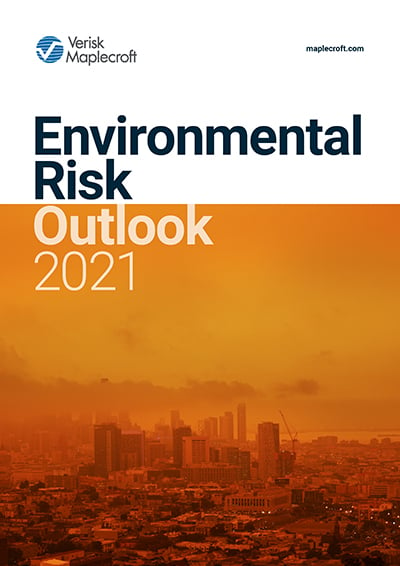Executive summary
Environmental Risk Outlook 2021
by Matthew Moshiri,
How well global organisations manage the escalating environmental and climate crisis is now one of the most critical factors determining their long-term resilience. And while a growing proportion of businesses are seeing the issue finally make its way into boardrooms, it’s right to question whether companies have put the necessary steps in place to address a crisis that will impact them across a number of fronts.
Alongside the physical risks posed by climate change, harsher regulations will emerge and mounting legal liabilities and reputational damage will become a real prospect for many businesses, due to their association with rises in global heating and the destruction of habitats. Additionally, the secondary and knock-on effects of climate change, from social unrest to economic and political instability, will present a complex landscape to be navigated.
Yet, while these challenges are largely foreseeable, emissions are rapidly returning to pre-shutdown levels, ecosystems continue to decline, and many organisations are simply failing to act. From a strategic perspective, optionality can provide flexibility to traverse a changing risk environment. However, the climate crisis will back some industries into a corner and force reactive decision-making if not appropriately – and collectively – dealt with in the near term.
This year, our Environmental Risk Outlook explores where the key challenges for business will emerge and how governments, investors and corporates can manage this growing body of risks in the face of everincreasing pressure from shareholders, regulators and customers. With the window closing for actions to minimise climate and environmental impacts, the question is now not only how will organisations respond, but how quickly they will do so.
Spotlight on city risk
For investors and operators, the fact that the world’s population is becoming increasingly urban raises a host of issues. Key among them are environmental risks from declining air quality, natural hazards and water availability – all set to be multiplied by climate change. Combining our data on all these threats to build up a picture of risk across almost 600 of the world’s largest cities, it is clear that Asia’s cities are right on the frontline.
Our data shows that the region is home to the vast majority of cities facing the greatest environmental risks, both man-made and natural. But no region is entirely immune. The different patterns of risks within continents – and even countries – go to show the importance of incorporating granular environmental data in corporate and investment decision-making.
2021 a turning point for carbon policy?
The question of how to tackle the carbon emissions that drive climate change comes sharply into view this year with COP26 on the horizon. Yet the G20 countries, accounting for 80% of global emissions, are not moving quickly enough to meet the Paris Agreement goals. Our analysis shows that despite strong performances from some, countries across the board are facing a disorderly and even abrupt transition to a world of much tougher emissions mitigation regulations.
For investors across all asset classes, time is running out to identify the threats and opportunities facing their portfolios and work to develop hedging strategies. And as for sovereign investors, with debt renegotiations and post-pandemic recovery packages there may never be a better moment to push lawmakers towards a more controlled carbon transition.
Biodiversity a budding ESG risk
While climate change has been a staple of investor concerns for several years, focus is intensifying around biodiversity risk. The potential for damage to corporate reputations is clear as societies become even more environmentally conscious, but lawmakers are also recognising the economic benefits of protecting important ecosystems and habitats.
This ‘natural capital’ ranges from attracting tourist dollars to pollinating insects, or adapting to climate change. Investor desire for greater information is driving new benchmarks and standards, but will also heap pressure on companies to track and disclose their impacts on nature. Companies and investors must also contend with weak governance and outright corruption muddying the waters around commodities and value chains.
The climate battle heads to court
As the pace picks up on carbon regulations, legal liabilities related to climate are also becoming more mainstream. Almost 3,000 cases have been lodged since the start of the century, primarily aimed at changing government policy or claiming compensation from fossil fuel companies for their contributions to global heating.
Although concentrated in North America and Europe, our new Climate Litigation Index shows that these types of lawsuits are now spreading into major emerging markets in Asia-Pacific, Latin America and beyond. Transport, mining and agriculture are also being targeted, while new claims around human rights and health are forcing corporates without sound policies and a clear grasp of future risks on the defensive.
The heat is on global cities
If emissions continue to rise on their current trajectory, we can expect soaring temperatures to transform the climate of northern US and European cities to resemble that of their sweltering counterparts hundreds of miles to the south. Londoners might envisage warm days in the park and an Italian café culture, but the reality for most cities is of widespread productivity losses, skyrocketing cooling costs, and a grim toll of heat-related disease.
Agriculture, manufacturing and other outdoor industries will be worst affected, but real estate investors and government officials cannot overlook the dangers lurking just 30 years ahead. Starting today to identify those risks and factor them into decision-making can help mitigate the impacts and even uncover opportunities in a warm-weather world.

